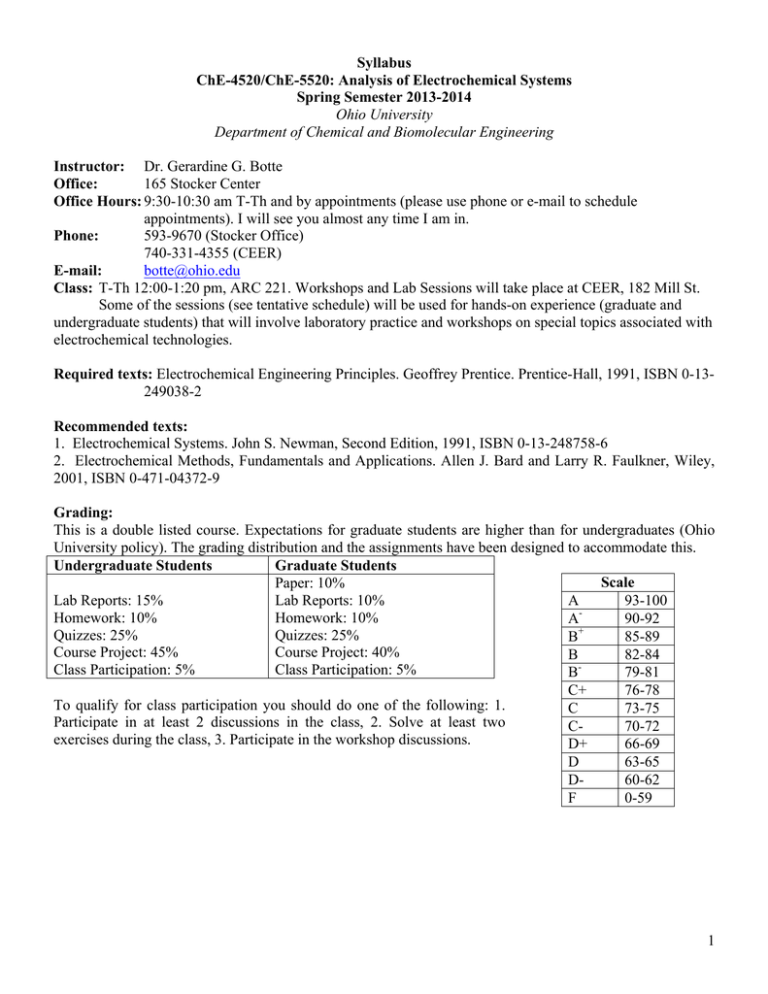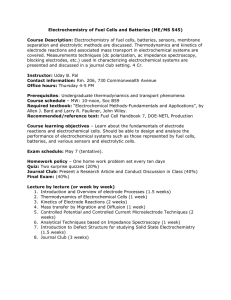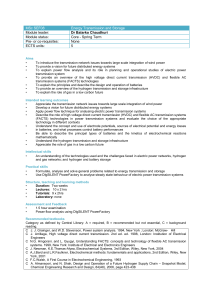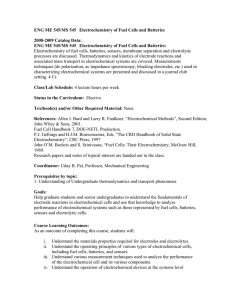Syllabus ChE-4520/ChE-5520: Analysis of Electrochemical Systems Spring Semester 2013-2014
advertisement

Syllabus ChE-4520/ChE-5520: Analysis of Electrochemical Systems Spring Semester 2013-2014 Ohio University Department of Chemical and Biomolecular Engineering Instructor: Dr. Gerardine G. Botte Office: 165 Stocker Center Office Hours: 9:30-10:30 am T-Th and by appointments (please use phone or e-mail to schedule appointments). I will see you almost any time I am in. Phone: 593-9670 (Stocker Office) 740-331-4355 (CEER) E-mail: botte@ohio.edu Class: T-Th 12:00-1:20 pm, ARC 221. Workshops and Lab Sessions will take place at CEER, 182 Mill St. Some of the sessions (see tentative schedule) will be used for hands-on experience (graduate and undergraduate students) that will involve laboratory practice and workshops on special topics associated with electrochemical technologies. Required texts: Electrochemical Engineering Principles. Geoffrey Prentice. Prentice-Hall, 1991, ISBN 0-13249038-2 Recommended texts: 1. Electrochemical Systems. John S. Newman, Second Edition, 1991, ISBN 0-13-248758-6 2. Electrochemical Methods, Fundamentals and Applications. Allen J. Bard and Larry R. Faulkner, Wiley, 2001, ISBN 0-471-04372-9 Grading: This is a double listed course. Expectations for graduate students are higher than for undergraduates (Ohio University policy). The grading distribution and the assignments have been designed to accommodate this. Undergraduate Students Graduate Students Scale Paper: 10% Lab Reports: 15% Lab Reports: 10% A 93-100 Homework: 10% Homework: 10% A 90-92 Quizzes: 25% Quizzes: 25% B+ 85-89 Course Project: 45% Course Project: 40% B 82-84 Class Participation: 5% Class Participation: 5% B79-81 C+ 76-78 To qualify for class participation you should do one of the following: 1. C 73-75 Participate in at least 2 discussions in the class, 2. Solve at least two C70-72 exercises during the class, 3. Participate in the workshop discussions. D+ 66-69 D 63-65 D60-62 F 0-59 1 Course description and objectives: Application of thermodynamics, transport phenomena, and reaction engineering to understand the performance of electrochemical systems and processes. Applications include electrolysis, batteries, and fuel cells. After successfully completing this course, you will be able to: 1. Gain a better understanding of electrochemical systems 2. Understand the thermodynamics of electrochemical systems 3. Recognize electrode kinetics 4. Understand the transport mechanisms in electrochemical systems 5. Understand modeling procedures for electrochemical systems 6. Get familiar with typical electrochemical instrumentation 7. Gain “hands-on” experience with the state-of-the-art sources of energy storage and conversion such as batteries and fuel cells 8. Design, build, and test an electrochemical process To fulfill the objectives of this course the class has been divided into mentoring sessions, lab sessions, and workshops. The mentoring sessions will be used for presenting new concepts and problem solving techniques. The students are expected to read and understand all of the material in the sessions assigned in the textbooks, class notes, and handouts. The course material will be presented using active learning. The instructor will act as a mentor for the class. New concepts will be introduced using a presentation style. Students will have class time to solve problems (using the taught concepts) and ask questions (individually and by groups). After sometime, the complete solution of the problem will be discussed in class. The lab sessions will be used to perform experiments that will allow you practicing the concepts presented during the mentoring sessions. You will perform the following experiments: 1. Lab I: Electrolysis 2. Lab II: Electroplating 3. Lab III: Fuel Cells Workshops sessions will be used to discuss new research areas and special topics. The workshops will consist of a presentation followed by a demonstration session. During the demonstration students will get familiar with electrochemical characterization techniques and fabrication methods. Even though the material cover in the workshops is not graded is important that you participate in the discussions, as they are part of class participation. It is suggested that you research on the topic before the class so that you can participate in the discussions and ask questions. Below is the list of the tentative workshops for the course: 1. Lithium ion batteries: In this workshop you will learn about the importance, uses, limitations, and research areas of lithium ion batteries. In addition, the students will go to the lab where four different working stations will be found: 1. electrodes fabrication, 2. battery assembly, 3. battery testing, and 4. battery performance. 2. Plating and electrode characterization: In this workshop you will learn about different plating techniques, advantages and disadvantages of plating, plating variables, and electrode characterization, etc. In addition, the students will go to the lab where seven different working stations will be found: 1. surface preparation, 2. electrode plating, 3. plating procedure schedule and data, 4. surface area, 5. adhesion, 6. morphology, 7. surface profile. 3. Fuel Cells: In this workshop you will learn about fuel cells, efficiency of fuel cells, types, advantages, disadvantages, fabrication of MEA, and design and economics of PEM fuel cells. To complete the discussion students will go to the lab where three different working stations will be found: 1. Fuel Cell performance, 2. PEM fuel cell parts, and 3. PEM economics in a spreadsheet. 4. Hydrogen Economy: Batteries vs. Fuel Cells: In this workshop you will learn about what is hydrogen economy, advantages and limitations of hydrogen economy, hydrogen production methods, and state 2 of the art on hydrogen production. To complete the discussion students will go to the lab where they will learn about the contributions of CEER to the hydrogen economy. Class Notes: Class notes for the topics will be available at the course webpage. You are responsible for printing and bringing the notes to class. Lab Reports: You will write a short report (maximum 5 pages) describing and discussing the findings observed during the experimental sessions. Your report should include the following sections: 1. Cover page 2. Data 3. Results and Discussion: discuss and answer the questions posted in the experiment handout 4. Calculations Your behavior during the experiment will be observed and it will be considered in your report grade (lab attitude, 5 points). More details about lab grading are given in the lab grading sheet. All results and data must include uncertainties. Use propagation of error to determine uncertainties, for more details see “Syllabus Support” document. Quizzes: These quizzes will be closed notes, except for one piece of paper with the necessary equations. Any material needed will be provided during the test, or you will be told to bring it with you. The material you are responsible for under each format will be explained ahead of time. Basically each quiz will cover the content of each topic in the class (see tentative schedule for quizzes content and dates). You will have 30 minutes for the quiz. Class project: As your class project you will design, build, and test an electrochemical system. The electrochemical system that you will work on will be an electro-chem-e-car. Details about the project are given in the Final Project handout. It will be a team project. The team members will be selected by the instructor. There won’t be more than 6 members per team. Homework: Homework will be assigned regularly during the quarter (see Tentative Schedule) and you are responsible for their solutions. Students are expected to attempt every problem and ask any necessary questions before their due dates. Homework will be due at the beginning of the class of the target day (usually you will have a week to do your homework). No late homework will be graded. Homework should be presented clearly. Homework that does not provide clear communication will not receive full credit. You are required to follow the homework standards given below: Homework Standards Below are given the minimum standards for assignments and homework: 1. All written homework and computer print outs are to be done on 8.5x11” white paper. Write on the front side of each page only. Do not crowd your work. 2. The first page of your homework must contain your name, course number, due date, and homework number. 3. Pencil is preferred. Pen is acceptable if there are no substantial splotches. Write neatly. 4. All pages, in the correct order, must be numbered sequentially in the upper right-hand corner: 1/7, …, 7/7, for example. Staple pages together in the upper left-hand corner. 5. Show your work. Your final answers must be marked in a block. 3 Homework Guidelines When your homework (or project) requires the analysis/design/optimization of an electrochemical system, you are expected to follow these guidelines: 1. Diagram: Always draw a diagram of the process. 1.1 Write down the electrochemical reactions in each electrode 1.2 Write down the overall reaction 1.3 Draw the schematic of the electrochemical cell 1.4 Identify: direction of the current, direction of the electrons, anode, cathode, polarity of the electrodes 1.5 Label all unknown variables with a question mark 2. Assumptions: State all assumptions clearly. 3. Equations: Write down all of the governing equations (in symbolic form) that will be needed to solve the problem. 3.1 Use the same variables as defined by the diagram. 3.2 Use narrative text where needed to explain how the equation will be used. 3.3 Do not begin by plugging in numbers. 4. Simplify: Algebraically manipulate the equations to simplify them as much as possible. 5. Solve: Insert numerical values and compute values of unknown variables. 5.1 Insert units along with values. Make sure the units are consistent and cancel so that the answer has the correct units. 5.2 Clearly mark the final answer with correct units. 5.3 Discuss the physical meaning of your answers. 6. Graphs: All graphs must be clearly labeled and explained using narrative text. 6.1 All graphs must have titles and axis labels with units. 6.2 Graphs should be done using a computer program (Excel) 6.3 Use different line types or symbols to distinguish multiple sets of data on the same graph. Use a legend. 6.4 Explain your graphs using narrative texts. 7. Spreadsheets, computer programs, and Matlab problems: All of them should contain narrative text that explains the functions, variables, etc used. Class Paper (Graduate Students Only): Graduate students are required to write a review paper for a topic that will be chosen by the students with the approval of the instructor (see list given for examples of different topics). The paper will be done by groups. The team members will be selected by the instructor. You must follow the structure of a review paper submitted to a peer review journal. Students are strongly encourage to research examples of how review papers are structure and written. When doing the analysis of the papers you must be critical. You need to focus on importance of the research (or paper), limitations of the paper, identify the progress in science due to the contribution of the authors, suggestions for future work and improvements. The following structure is suggested for your paper: 1. Abstract 2. Introduction 3. Review of Papers: this is the section where you have to be critical (positive and negative aspects of the paper, importance of the paper, suggestions for future work. e.g., techniques used, materials tested, methodology employed, etc). See example given next, which was done for the analysis of the paper entitled: “Hydrogen production from coal water and electrons” by Coughlin and Farooque Most of the studies available in the literature on electrolysis of coal/water slurries have been performed in batch systems (bulk electrolysis). None of the studies have been performed at pressures different than atmospheric. The thorough review 4 presented next shows that it is necessary to perform additional studies for the design of a continuous coal/water electrolysis system; in addition, the studies must be performed using Ohio coal. Coughlin and Farooque4 reported the kinetics and thermodynamic feasibility of electrolyzing coal/water slurries. They did their experiments using Pt electrodes; however, they indicated that they did not observe significant differences in the electrochemical reaction when using graphite electrodes. The authors proposed that the electro-oxidation of coal/water slurries take place according to the reaction given in Eq. 1, while the reduction of hydrogen cations takes place at the cathode: 4H + + 4e− → 2H 2 (2) C + 2H2O → CO2 + 2H2 (3) Therefore, the total reaction is given by: The theoretical potential required for the oxidation is 0.21 V, which represents, 11 W-h/H2 mol. The theoretical energy consumed is much lower than for the electrolysis of water, 66 W-h/H2 mol. The authors4 reported that the process produces practically pure streams of hydrogen at the cathode and carbon oxides at the anode (CO2 with 3 to 7% CO). The authors noticed differences in the oxidation behavior of different coal samples: Montana Rosebud (char and coal), North Dakota lignite, Pittsburgh coal, and Illinois No. 6. Montana Rosebud was easier to oxidized and generated higher oxidation currents (faster reaction rate). The authors attributed the different behaviors of the coals to particle size (smaller the better), surface area (higher the better), and graphitic nature (effect of electronic conductivity, the higher the better). The authors4 noted a decrease on the oxidation rate with time. They claimed that it may be due to the formation of films on the coal surface (e.g., surfaces oxides, hydroxyl, carbonyl, or carboxyl groups) as reported by other researchers.16-18 However, they did not perform any surface analyses. Some researchers1 have reported that the presence of CO poisons platinum electrodes decreasing the reaction rate, therefore, it is possible that part of the behavior observed by Coughlin and Farooque4 was due to CO poisoning, but this argument was not suggested or analyzed in their paper. They4 also noticed that either by heating the coal up to 200 oC or by washing it with some organic solvent (e.g., acetone) the coal was reactivated (this procedure probably destroys the films on the surface of the coal). Another important observation made by the authors4is that the ratio of the gases formed did not agree with the stoichiometry of the equations shown above (Eq. 3). Much less gases were collected at the anode than at the cathode. The reason could be due to a build up of the films on the surface of the carbon. It is our opinion that also, if CO2 is formed in an acidic medium, another reason for not collecting gases according to the stoichiometry is that CO2 is much more soluble in water than O2, in addition, CO2 can react with water and formed carbonic acid (H2CO3). This possibility was not analyzed by the authors. 4. Trends and Future work 5. References Your paper should not be more than 20 pages (excluding cover page and references), double-spaced with font size 12. Keep 1” margins (right, left, top, and bottom). Number all the pages. The following is an example list of different topics: 1. Coal Fuel Cells 2. Solid Oxide Fuel Cells 3. Alkaline Fuel Cells 4. Lithium Batteries 5. Flow Batteries 6. Electrochemical Engineering and its Contribution to the Hydrogen Economy 7. Electrochemical Engineering and its Contribution to the Environment 8. Electrochemical Biomedical Sensors 9. Lab on a Chip and Electrochemical Applications Attendance: Students are expected to attend every class and lab session. If you miss an assignment or exam, contact me to schedule a makeup. There most be an honorable excuse for a makeup exam. If you know you will miss an exam, speak to me in advance to make arrangements. Refer to "Class Attendance" in the Student Handbook for the Ohio University policy on unanticipated absences. 5 Academic Conduct: Engineering is a profession, and ethical behavior is expected of professionals. You are expected to act in a professional manner in this course. Academic dishonesty is defined in the Student Handbook and will be dealt with according to the guidelines therein. Exchanging information on assignments or exams where such an exchange has been forbidden and plagiarism are violations of the standards set forth in this course and the Student Handbook in general. Appropriate penalties will be imposed, which could include failing the course and a referral to the Office of Judiciaries (refer to the Student Handbook for descriptions of unethical behavior and the potential penalties). Other potential violations include any action that deceives your professor or your classmates, and any action taken without due consideration of its possible harmful effect on others. I would not accept disrespect to me or to any of the students in the class. If you act in this way you will be asked to leave the classroom and you will loose any credits for the activity that takes place that day (including lab sessions and exams). You must have an appropriate conduct during the lab sessions. Disability Services: Any student who feels s/he may need an accommodation based on the impact of a disability should contact me privately to discuss your specific needs and provide written documentation from the Office of Disability Services. If you are not yet registered as a student with a disability, please contact the Office of Disability Services at 740-593-2620 or visit the office in 348 Baker University Center. Students must meet with me (instructor) to deliver the faculty notification letter from the Office of Disability Services and discuss specific arrangements for accommodations during my office hours within the first three weeks of the semester. The student who is requesting the accommodation must speak only with the instructor about the accommodation and must deliver the faculty notification letters in person only to the instructor of the course. For more information about the Office of Disability Services visit: http://author.oit.ohio.edu/disabilities/. 6





